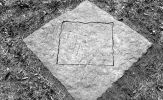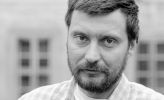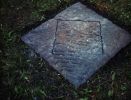Entarctic Shelf Festival: 23 June – 3 July, 1995
A flat stone slab was placed in the center of the convent yard. The carved form referring to the shape of the building was sunken slightly into the surface as a reference to the subterranean water system underneath the building.
M. Z., 1995
A stone square in the middle of a rectangular courtyard was turned for 45°, a work without text. If some words should be associated with it, then it was the name. I do not remember exactly — “Bottom water”, “Ground water”, “Underground waters”? I explored in the underground system of Plasy what I could — the tanks, the foundations, the cavity in the double wall, the water tunnels — the canal — flowing under the building and the yard. A slashed stone block — the inner part removed and set back in slightly deeper — is the center of gravity of the giant building, which was erected in a swamp, a hint to the continuous activity of water beneath the surface.
M. Z., 2017
Martin Zet (1959) studied sculpture at the Academy of Fine Arts in Prague from 1979-1985. He lives and works in Libušín, a village to the west of Prague. Zet creates using a full range of media, including video, sculpture, drawing, found objects, writing, performance and Photographery. He worked at The Faculty of Visual Art at the Technical University in Brno as head of the Video Department and at the Center for Audiovisual Studies at FAMU in Prague. His career spans several decades, and he has performed or exhibited all over the world. Zet is an artist moving outside streams and groups, with a sense of balance between personal and socio-political realities.







